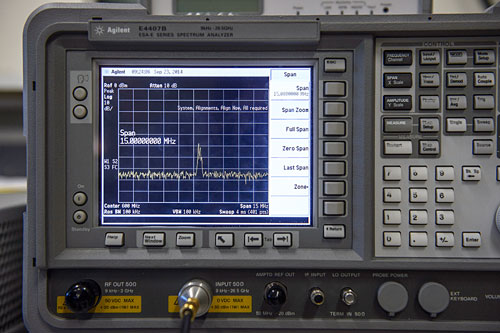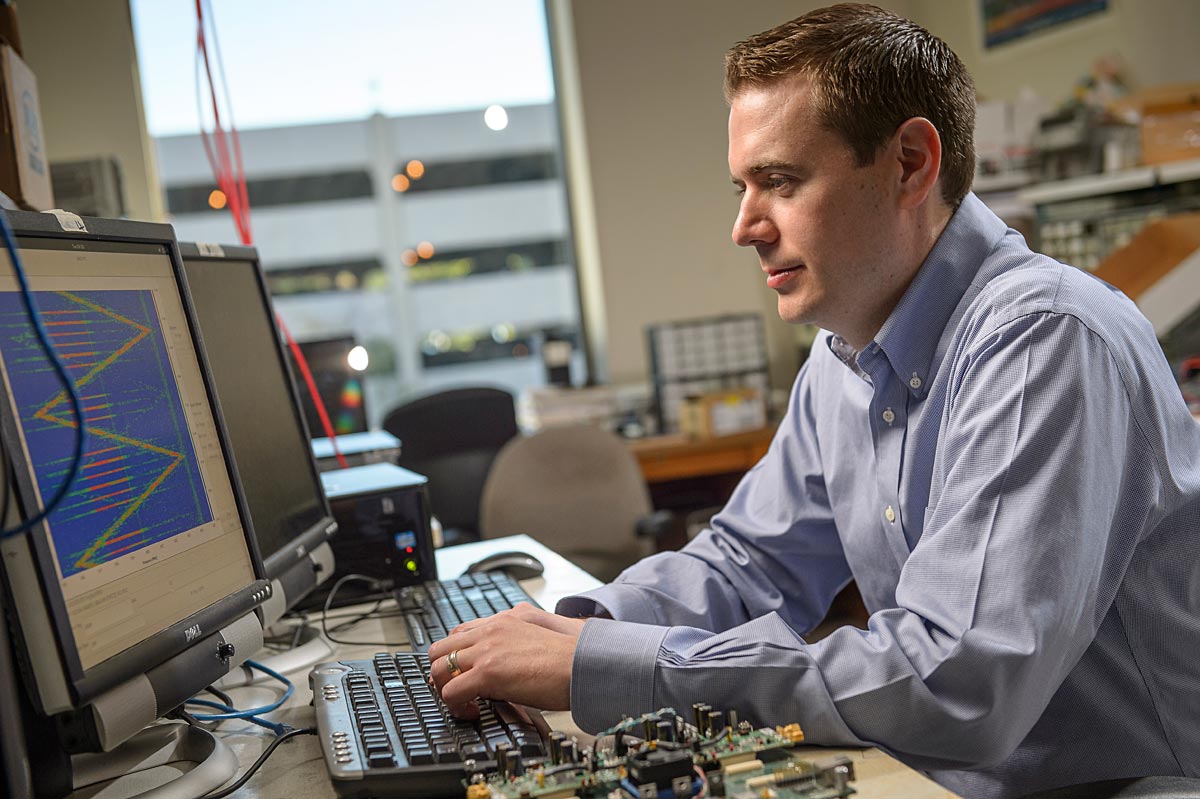Purdue researchers are doing their part to avert a potential spectrum crisis that threatens wireless communications, including development of a small-scale spectrum-sensing network to help address the issue. They are also investigating innovative applications that would benefit from more efficient spectrum management, including a project that targets gang graffiti.
Purdue researchers are doing their part to avert a potential spectrum crisis that threatens wireless communications, including development of a small-scale spectrum-sensing network to help address the issue. They are also investigating innovative applications that would benefit from more efficient spectrum management, including a project that targets gang graffiti.
The potential spectrum crisis is a predicament catalyzed by the proliferation of smartphones and other mobile devices and an explosion of data-intensive applications. The increase in demand may soon strain the capacity of radio frequency bands used for wireless communications, while impacting use of bands that are protected for other uses.
“Hitting capacity is inevitable if we continue our growth in data demand, which has taken off exponentially,” says David Love, a professor in the School of Electrical and Computer Engineering. “It’s a very big and a very important problem.”
The problem could be attacked by introducing a technology that senses when frequencies are not in use so that they could be made available to other users. Purdue researchers recently created a small-scale version of just such a spectrum-sensing network while competing in the DARPA Spectrum Challenge, a tournament-style contest culminating in the spring of 2014. The Purdue team won the preliminary round for its work. The contest involved development of both software and hardware components and applying them to communications systems.
James Krogmeier, a professor of electrical and computer engineering who led the Purdue team, says, “These kinds of networks theoretically could be built out over cities. You want to make a telephone call and the sensing network knows a band over there is unused, so I can allocate that channel to you for the next five minutes. It has the potential to be a lot more flexible and perhaps to encourage much higher efficiency of the usage.”
Addressing the problem of interference
Such innovation will be needed to reduce interference hindering cellular communications, which depend on a series of base stations that provide service to separate regions called cells. Performance is compromised by interference, a growing problem as networks become more complex.
The interference wasn’t such an issue in the early days of cellphones, when signals were transmitted directly from a single source to a single receiver in a procedure known as point-to-point. But communications have evolved since then into far more complex cooperative multipoint systems. “The issue today is that systems are no longer point-to-point,” Love says. “You have nodes interfering with each other and many networks.”
Love leads a research team on efficient-spectrum management with Krogmeier; William Chappell, professor of electrical and computer engineering; and Edward J. Delp, the Charles William Harrison Distinguished Professor of Electrical and Computer Engineering and a professor of biomedical engineering. The team is one of four research groups selected by the College of Engineering as priority areas for faculty hiring, part of the college’s strategic growth plan that will add as many as 107 faculty members over five years. Known as preeminent teams, these groups were chosen because they have the potential to advance research in critical areas. Research in efficient-spectrum usage earns the distinction because of the social significance of wireless communications, the ubiquity of smartphones and the surging demand for data transmission.
“In addition to the technological challenge, it’s a huge political and social problem,” Krogmeier says. “It’s becoming a problem largely because of smartphones. Everybody’s got one. We’re all using way more data than we ever did before.” Applications such as Snapchat, for example, which allow users to send messages that include images and short video and audio clips, are contributing to the greater demand. “This is the game that everyone is playing. People want this service,” he says.
New technology and policies that allow for a more efficient use of the increasingly congested radio spectrum will likely be needed to ensure reliable communications. The Purdue research is supported in part by industry, and the team’s practical orientation spurs the creation of new intellectual property. “We’ve had a number of patents,” Love says. “One thing that’s strong about our team is that it really has an industry connection.”
Educating a new generation of engineers fluent in the technology will also serve to speed its adoption into practice.
National call spurs research
The Purdue effort comes at an opportune time. Congress approved a national broadband plan in March 2010, and the White House in 2013 announced a $100 million investment in spectrum initiatives. One of the new faculty members will likely be conversant in the complexities of regulation and policy that govern wireless communications.
“You could argue that solving this problem takes a two-pronged approach, one to understand the policy-regulation-economics of it, and another to focus on the engineering,” Krogmeier says.
Regulation and policy changes could help to correct one flaw in the current system: Companies that lease cellular bands have full access regardless of whether they are using the bands efficiently.
Finding answers
The team also is approaching spectrum-usage inefficiency from an applications perspective. “How do you design applications in an efficient way to use the available bandwidth that exists?” says Delp, the team’s applications leader.
His group is working on two major applications that would benefit through more efficient spectrum management. One is the GARI project to enable cellphones and other portable devices to translate the meaning of gang graffiti for law enforcement. GARI stands for Gang Graffiti Automatic Recognition and Interpretation. “You take a picture of the gang graffiti with a mobile phone and then the system interprets the images,” Delp says.
The research is part of the Visual Analytics for Command, Control and Interoperability Environments Center of Excellence, or VACCINE, headquartered at Purdue. The system uses image-analysis algorithms to translate the graffiti. Pictures are sent to a server for analysis. Because the process is image-intensive, it will require far more bandwidth once widely adopted.
“So one of the things we need to do is develop a more intelligent way of using the bandwidth that exists,” Delp says.
GARI, created in 2011, is now being used by several law enforcement agencies including the Indiana State Police and the Cook County (Illinois) Sheriff’s Office. “Law enforcement has already inserted thousands of images into our database,” he says, “so it’s moving along.”
The other application is TADA, for technology assisted dietary assessment. “The general idea is that you take pictures of your food and send them back to a server,” Delp says. “The server analyzes the picture and tells you how many calories you are eating. So applications like these are going to require a lot of bandwidth.”
One strategy for efficient operation is to process images in ways that minimize bandwidth use. “Do you process the image on the phone or do you process the image by sending it to the cloud?” Delp asks. “Or do you have some processing on the phone and some on the cloud? It’s a complicated bandwidth-tradeoff problem."
Another emerging phenomenon that will necessitate greater wireless bandwidth is the Internet of things. “It has to do with everything having an Internet address: your watch, your car, the washing machine. All of that is going to require more wireless bandwidth,” Delp says.
No matter what concepts are pursued to avert a spectrum crisis, however, one fact is certain: The telecommunications industry is at a turning point, and its future health depends on making the right decisions now.
“The industry is at a point where it could go off in a very wrong direction,” Krogmeier says. “For example, we could overregulate, stunting capacity and future progress in wireless communications. There is a lot of money to be made if the right steps are taken now. But the old regulatory model probably isn’t going to work.”



